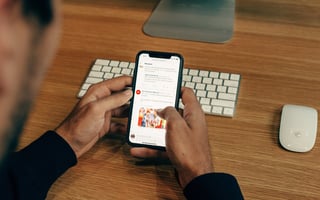If you’ve been on social media recently, chances are you may have seen posts calling for a boycott...
Video has become a crucial part of our everyday lives.
But our use of it needs to go beyond video conferencing. Video needs to become an integral part of wider communication strategies.
And although that may sound expensive, it doesn't need to blow your budget.
Here are 7 reasons why you need to embrace the power of well planned, lit, and recorded video on a mobile.
Cost-effective
Creating video has traditionally been seen as an expensive option, involving the use of camera crews and studios.
But not anymore. Now you and your teams have everything you need in your pockets.
Your smartphone will not only enable you to capture high-quality 4k footage, but you can also edit it. It is essentially a full video studio.
All you need is a bit of guidance on capturing the right footage and making it look and sound great through the editing process.
Our new interactive online course guides you through everything you need to know about making videos that not only look professional but make people stop scrolling and watch.
Improved Internal comms
Smartphone video is increasingly being seen as a key internal communications tool.
And it is easy to see why.
It enables your people to quickly take in important information and updates at a time that is convenient for them.
This is particularly beneficial in the current landscape where all or part of the workforce may be working remotely and trying to balance regular online meetings with ensuring they get their work done and dealing with home commitments.
Video messages can also be absorbed in a fraction of the time it takes to read a long email or intranet report and in that shorter time, it can be easier to convey ideas, concepts and even emotions.
It is also a great way of showing visible leadership and helping to ensure workers feel connected.
Just seeing regular video messages from the leadership team can be greatly reassuring for workers at a time when there are a lot of uncertainties and speculation.
And it can help to show a human connection between those leaders and their teams. We recently put together a video for our tutors to thank them for their efforts in 2020 and the way they had adapted to all the changes of the past year, and it received a much bigger response than we would expect to see with an email.
Another way video is being used in internal comms is to provide CEO interviews. Here questions are put to the boss by a member of the internal comms team, another senior leader, or even a journalist if you are really striving to create an impression of openness and transparency.
But it is also a great tool for providing organisational news and updates, training and staff inductions.
Active role
Using smartphone video can encourage your employees to play a more active role in your internal and external communication.
Virtually all of us have access to the kit and making videos feels new and exciting.
Adopting more video in your plans could see more people come forward with ideas and even send in their own footage.
As long as you have clear guidance on what type of content the organisation is looking for, having more people wanting to play an active role and generating content can be an enviable position to be in.
Crisis management
Video is also being increasingly used in crisis media management.
It can help organisations to show the situation is being managed at the top and ensure customers see the messages it wants to get across, including apologies and examples of the action it is taking to resolve the issue.
A great example of this was provided by Starbucks when it found itself facing a PR disaster and social media boycott after two black men were arrested at one of the store’s coffee shops in Philadelphia after an employee called police to say they were trespassing.
CEO Kevin Johnson subsequently issued a video apology on the company’s website where he took responsibility for the incident and sounded genuinely remorseful.
He said: “Now, there has been some calls for us to take action on the store manager. I believe that blame has been misplaced.
“In fact, I think the focus of fixing this, I own it. This is a management issue, and I am accountable to ensure that we address the policy and the practice and the training that led to this outcome. “
Social media
As we mentioned at the start with the YouTube statistics, video is becoming increasingly important.
If you want a bit more evidence, views of branded video content have also increased by 258 per cent on Facebook. And on Twitter, a video Tweet is now six times more likely to be retweeted than a photo Tweet.
If you are not using video on your social media channels then you are going to fall behind.
But some video performs better than others. If you think about the videos that make us stop scrolling on our own social media accounts, it doesn’t tend to be the glossy corporate ones.
There’s still a time and a place for those, but on social media, we are more naturally drawn to ones that are made on phones because they look authentic and are typically timely.
Social media users want content that informs, educates and entertains and video is one of the best ways of achieving that.
But it isn’t as simple as just shooting a video and posting it.
With so much content at their fingertips, viewers lack patience and need to be quickly convinced that their time is going to be well-spent watching the rest of your video.
In fact, you have got just a few seconds – Facebook counts a ‘view’ as three seconds and above.
Headlines and opening shots play a key role in achieving this and this is something we explore in more detail on our online course.
Marketing
Video can also play a key part in your marketing strategy.
Interviews with your experts can help present your organisation as a thought leader and showcase its talents and thinking to a wider audience.
When we get back to live events and conferences, smartphone video can be used to capture what has happened, including interviews and parts of key presentations.
It can also be used to demonstrate new products and services and explain to your customers how it can help them.
And, again, all of this can be done with a smartphone.
SEO
It is not just customers who love videos.
Search engines have a soft spot for them too and regard them as high-quality content which can boost rankings.
Google and co are responding to consumer demand for more video content.
Additionally, people spend more time on websites with videos and the longer people stick around, the better your site will rank.
Keen to find out more about using smartphone video in your comms strategy?
Our online course not only shows you how to capture and edit footage, but we also explain what makes video content standout and the publishing tips to ensure it receives more views.
The training is led by Anna Brees, a familiar face you will recognise from TV news, and because it is online, it can be completed when you are ready.
Media First are media and communications training specialists with over 35 years of experience. We have a team of trainers, each with decades of experience working as journalists, presenters, communications coaches and media trainers.
Subscribe here to be among the first to receive our blog.




